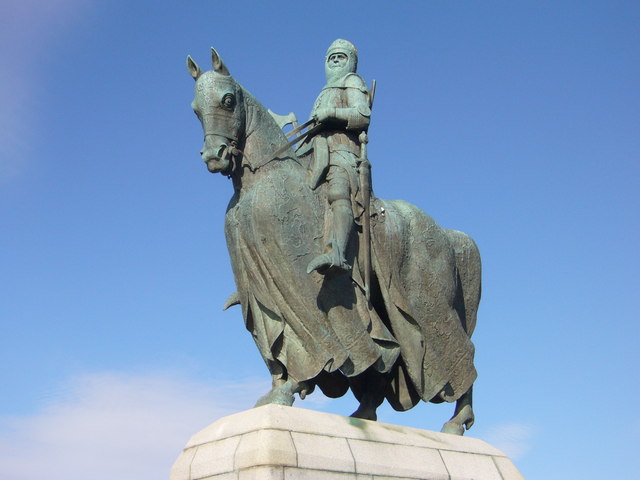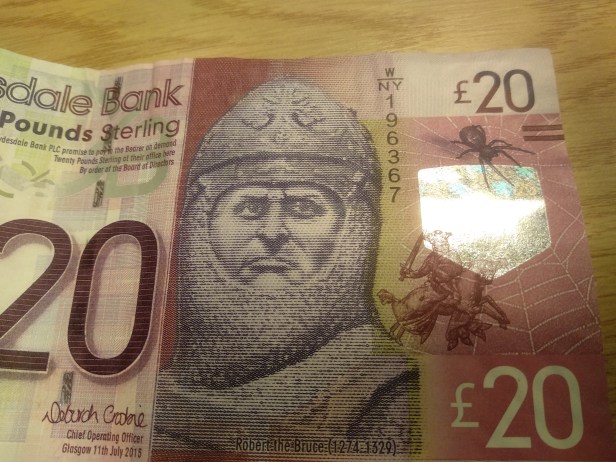How a tiny cave spider could have possibly changed the destiny of Robert the Bruce, King of Scotland, and the fate of his nation? In 1307, Robert the Bruce, an outlaw king, had helplessly watched his wife, daughter and sisters being imprisoned. Three of his brothers had been executed by the English, and he had no piece of land he could call his own. To the English, he was a traitor, and to the Scots, a murderer and usurper.Discover how a tiny spider (and it wasn’t the radioactive one that bite Spiderman) reversed the irreversible, and turned Robert into the legendary hero who defeated the English in the First Scottish War of Independe nce (1296-1328).
#1 The Bruce’s ancestry
Robert the Bruce was born 11th July 1274, probably in Turnberry Castle. His father, Robert de Brus, had married Marjorie, the widow of the Earl of Carrick, and thus Robert Jr. inherited the Earldom of Carrick. The Bruces, or Bruses, were a family with Anglo-Norman origins, and were counted amongst the most powerful in Scotland. And very feared, because of their ambition.

Scotland faced a crisis in 1286, when King Alexander III died, and then his granddaughter and heir, Margaret of Norway, followed suit in 1290. When I said little problem, I meant the country was on the brink of a civil war. The Bruces and the Balliols, another powerful family, had both claimed the throne. To settle the dispute, they had the brilliant idea to invite, for tea and biscuits, the powerful and ambitious English King, Edward I.

Edward I, jealous of the superior beauty of the bonny Scottish glens compared to the plain English countryside, saw a golden opportunity to assert his dominance over his otherwise poorer, northern neighbour. In 1292, he decided in favour of John Balliol, who, like most of the Scottish nobility, had sworn allegiance to Edward in return.
#3 William Wallace. Freedom!
The status quo remained until 1296, when John replied to Edward’s muster of Scottish troops, with an unambiguous ‘Fuck off’, and sided with Edward’s foe, the French. Understandably, this angered Edward beyond measure and he reacted by dethroning John Balliol in a swift invasion, subtly leaving English officers behind to administrate Scotland. Instead of quiet acquiescence to their new English lords, what followed in Scotland was a continuous state of skirmishes and revolt led by William Wallace, (if you haven’t watched Braveheart, it’s time now. But do not expect historical accuracy!), the stubborn champion of Scottish resistance.

On the other hand, Robert swapped allegiances like a football player biding for the highest wage. Under a temporary truce, Robert and John Comyn, ‘the Red Comyn’, another of the Bruce’s enemies, shared the office of Guardian of Scotland (the ruler in the King’s absence) replacing William Wallace in 1298.

But Robert and John Comyn behaved like a bitter old couple, and their ‘marriage’ soon collapsed, after John, in what was clearly a domestic violence case, put a knife to Robert’s throat in the Selkirk forest conclave. What a dick. Robert went to seek refuge with Edward I in 1302, to the winning side. Or perhaps he was attempting to make John jealous?
#4 King Robert the Bruce
But it was plain to see that his affair with the English king was short-lived. Robert had never gave up his family’s claim to the Scottish throne. On 12th February 1306, tired of being Edward’s little bitch, Robert convinced John Comyn to meet him in Greyfriars Kirk (Church) in Dumfries. And if there’s an absolute truth in this world, it is this: going back to your ex is never a good idea.
The hopeful reunion ended with Robert stabbing and killing John, on sacred ground, earning him excommunication, the resentment of the Comyns and their allies, and a feud with Edward, all in one shot. Not the best idea Robb Stark. (My bad, wrong dynastic drama) His plan to get Comyn’s support thwarted, Robert was hurriedly crowned King of Scotland, by Bishop William de Lamberton. Meanwhile, his friend, the Bishop Wishart, absolved him of the murder, and urged the Scots to rally under Robert.

#5 Robert battles England
His clumsy bid for throne didn’t last long, or so it seemed, because on 19th June 1306, his four thousand strong army was routed and obliterated by the English. Robert made it out alive with fewer than 100 followers, his strength in Scotland shattered beyond repair.
Little better than a fugitive, Robert sent his wife, Elizabeth, his daughter Marjorie and sister, Mary, to safety with his brother, Neil Bruce, in Kildrummy castle. Meanwhile he and his little party hid in the mountains between Argyll and Perthshire.
The worst was yet to come…
#6 The fate of Robert’s wife and daughter
Kildrummy Castle was taken, and Neil Bruce was drawn, hanged and beheaded. Elizabeth, Marjorie, and Mary were later captured by Balliol’s adherents. Mary Bruce got the worst lot, being locked in a cage suspended in Roxburgh Castle during 2 long years. Edward wasn’t into the deference of opening the doors to women and other sorts of courtesy.
Elizabeth got away with a comfortable confinement, because she had mocked their enthronement to Robert. She allegedly said, during the coronation, that they would be King and Queen of the May. Wives… always so supportive.

7# Escaping to Rathlin island. Bruce’s cave
Robert’s only choice was to flee from Scotland. There are many theories where he spent the 1306-7 winter. Some say in Norway-controlled Orkney, or in Norway itself, where his sister, Isabel Bruce, was the Queen Dowager.
Other plausible alternatives are the Hebrides and Ireland. The strongest theory suggests that Robert stopped in the island of Rathlin, the northernmost point of Ireland. Hungry, cold, and fearful of Edward’s loyalists, Robert took his men to a cave, to shelter from the inclement weather.
#8 The legend of the spider
He had lost the throne, his earldom, his allies, his country and his family. Edward’s strength was unassailable, and one can only feel sympathy for Robert, thinking about giving up. But while sitting in the cave, he was distracted by a spider, which in vain, was trying to spin a web between the walls. Six times the spider failed, obstinately climbing the wall to try once more.
When 99% of us spot a spider, what we do is panic and try to crush it with supernatural strength, using a rolled newspaper, or we spray the whole can of insecticide upon the poor eight-legged bug. But Robert had little to lose, and watching the spider’s struggle might had been the only amusement available, in a damp cave offshore.
Robert realized that he too had failed six times against Edward. If the spider succeeded, then he vowed to try one last time. The headstrong spider persevered, and leapt against all odds. And succeeded! It reached the opposite wall.

#9 From Loudon Hill to Bannockburn
The terrible loss of his brothers Thomas and Alexander still awaited Robert, and he wouldn’t reunite and hug his wife and daughter until 1314. However, the achievements and battles Robert was soon to heap, could only had been imagined by some script writer of an epic Hollywood adventure film. King Robert returned, and began his legend by defeating a superior army at Loudon Hill. One by one, he conquered all the castles, eliminating the Comyn supporters in the process, and finally met and defeated Edward’s I successor, Edward II, at the battle of Bannockburn, in 1314. Robert the Bruce starred in one of the most spectacular comebacks ever.

#10 The spider’s proverb. Try again and again
All thanks to a revolting spider? We’ll never know for sure if Robert was actually inspired by it. Most likely, since motivational books weren’t available back then. And is it that unrealistic, considering one of the most popular and iconic superheroes today, is called Spider-Man?
Nowadays, Robert the Bruce, together with William Wallace, holds a place in the Scots’ hearts, as the achievers of independence, two bulwarks of national pride. And Spidey? The Spider remains equally important, a valuable lesson teaching us, that if at first we don’t succeed, we must try, try, and try again. And for that, the spider has earned a spot in one of the most revered pieces of paper: a £20 Scottish banknote.



I like the spider story and can understand why you missed it in the film! If true, that’s a very thin line (or web) between the Scots overthrowing the English versus being subjugated forever!
LikeLike
It’s true how we seldom appreciate how hisoty could had been so different in a wink of an eye
LikeLike
*history
LikeLike
I love your style 😂👌🏽
LikeLike
Thanks Ali. Keep in tune for more every Saturday
LikeLike
Whoever wrote this is a blooming idiot.
Bad grammar, loaded with hackneyed words and phrases. Idiotic metaphors.
Profane.
Probably taught by those who majored in education.
Never, ever make education a major. A talented teacher must be, first and foremost, a scholar.
LikeLike
If you feel the need to insult then please do so elsewhere. Or better, write something yourself, although it’s doubtful you possess the discipline and drive of what you call a scholar
LikeLike
I had somehow never heard the spider story before. Thanks for sharing it!
LikeLike
You’re more than welcome! This Saturday I’ll launch facts about Wallace if you like Scottish history
LikeLike